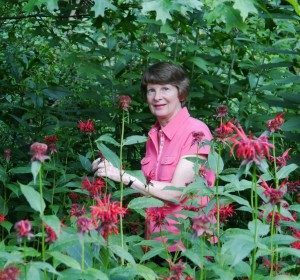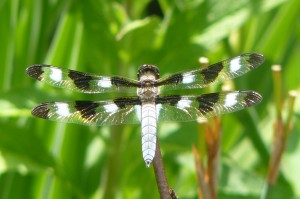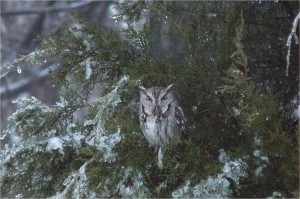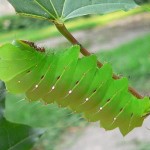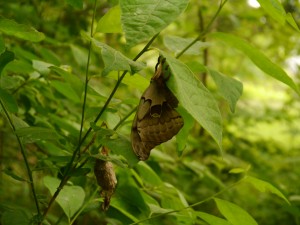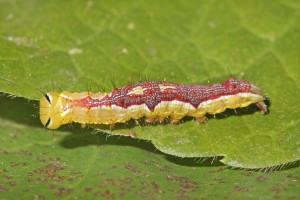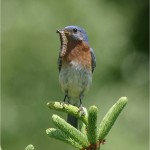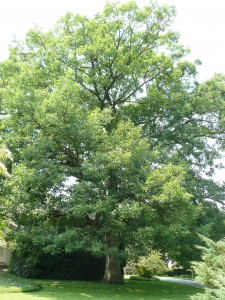By Edie Parnum
In early June I visited Barb’s backyard. As we toured her half-acre suburban property, we observed bees, butterflies, caterpillars, dragonflies, frogs, and birds–all leading busy lives.
Her yard wasn’t always full of life. Originally, her Southeastern Pennsylvania property had just grass and a few mostly non-native ornamental plants–nothing to attract wildlife. On a plane trip about 18 years ago, Barb read an article in the airline’s magazine about gardening for wildlife. Native plants, even when planted on a small property, could, the author asserted, provide a healthy habitat for birds, butterflies, and other creatures. For Barb, reading this article was a transformative experience. Over the years she has gradually added over a hundred native plant species, creating this haven for wildlife. She’s posted a sign: National Wildlife Federation-certified Backyard Wildlife Habitat.
We started our tour near Barb’s kitchen window—an area where she can view wildlife activities from inside. Originally, there were peonies and lambs’ ears, non-native plants with no appeal to animals. Barb substituted native perennials and shrubs that produce fruits, seeds, and nectar for birds and butterflies. Native insects eat the foliage of these plants; they, in turn, are food for birds and other animals. Barb added a birdbath, woodpile, nest boxes, and hummingbird feeders. We watched a hummer visiting her feeders and a House Wren using the nest box. Barb told me the Carolina Wrens love the woodpile. One day she spotted a Brown Thrasher scratching and feasting on bugs in the leaf litter. Last winter she discovered and closely monitored a cocoon in the Spicebush (Lindera benzoin). Her diligence was rewarded in May when a gorgeous six-inch Polyphemus moth emerged.
Frogs were the primary entertainment. We could hear the Northern Green Frogs calling from Barb’s 13-foot circular pond. We counted seventeen and probably missed others hiding in the water and under the plants. Intent on attracting mates, they inflated their balloon-like throats and called out like banjos. They lunged from their perches to catch insects and other prey. With its native aquatic plants, recirculating pump, waterfall, shallow “stream,” and deeper pools of varying depths, Barb’s pond has places for birds to bathe and for dragonflies and frogs to lay their eggs. Tadpoles and dragonfly larvae find their niches. With the frogs and dragonfly larvae feeding here, fortunately, mosquito larvae can’t survive here to become biting adults. Much to Barb’s delight, her backyard pond is a healthy, balanced aquatic ecosystem.
We visited some of Barb’s favorite trees. In her blight-resistant American Elm (Ulmus Americana, she’s spotted Baltimore Orioles and other birds feeding on the caterpillars in the foliage of this high wildlife-value tree. Because we found holes in the leaves but no live caterpillars, we concluded the munching caterpillars had been picked off by birds. We also stopped to see Barb’s beloved Eastern Red Cedars (Juniperus virginiana). Scores of bird species eat their berries. Song Sparrows and Mourning Doves have nested in the dense foliage. During a winter ice storm, she spotted an Eastern Screech Owl taking shelter in one of these cedars.
Barb has been encouraging me to appreciate native pollinators, so we visited her Monarch-friendly milkweed plants. We observed bees and butterflies enjoying the nectar of the blooming Swamp Milkweed (Asclepius incarnata), Common Milkweed (A. syriaca), and Butterfly Weed (A. tuberosa). We also saw her Purple (A. purpurescens) and Whorled (A. verticillata) Milkweeds. A keen observer, Barb finds the Monarchs’ tiny eggs on her plants and the browsing caterpillars, too. Monarchs require milkweeds as host plants. In acknowledgement of Barb’s role in helping this declining species, Monarch Watch has certified her property as a Monarch Waystation.
We saw many other native plants that day–and plenty of birds, butterflies, bees, dragonflies, and damselflies, too. In her yard, she has hosted over 85 species of birds and 25 kinds of butterflies. Her yard is no longer a dead zone. Barb says, “I can go out my back door and see wildlife happenings at any time. “
__________________________________________________
You can tour Barb Elliot’s yard on Saturday, July 7 between 10 am and 4 pm as one of eight locations on the Tredyffrin Eco Tour. Come see all the yard’s features, including her bat house and bee homes. Purchase your admission badge ($10 per adults, kids free) at the Tredyffrin Township Library parking lot located at 582 Upper Gulph Road, Strafford, PA 19087 from 9:45 am to 3:00 pm. For more information, go to http://www.ttdems.com/2012/06/join-our-backyard-eco-tour-july-7th/

